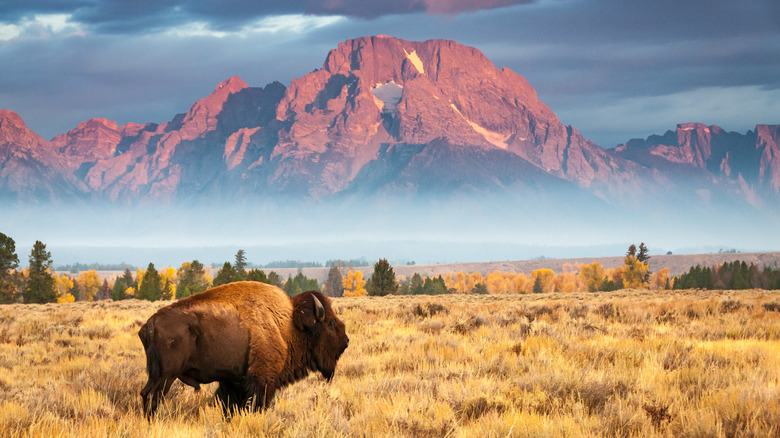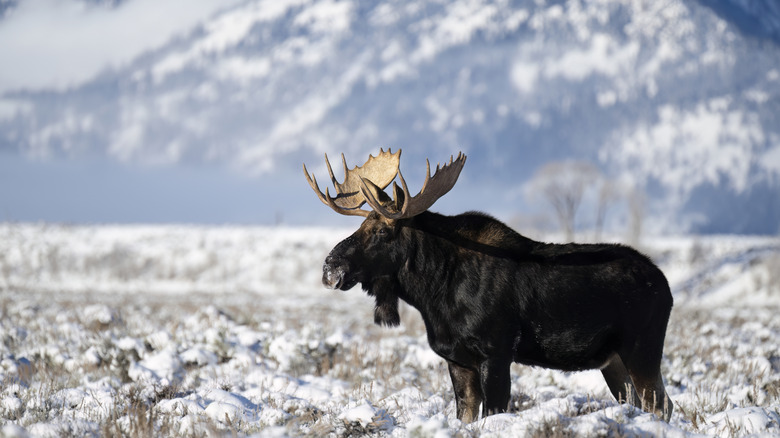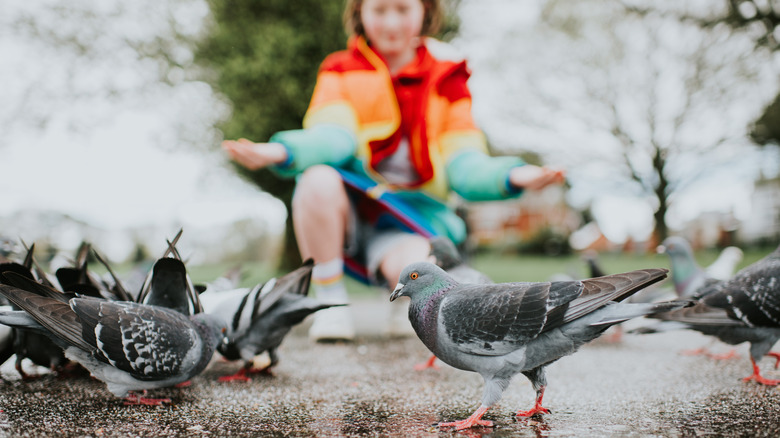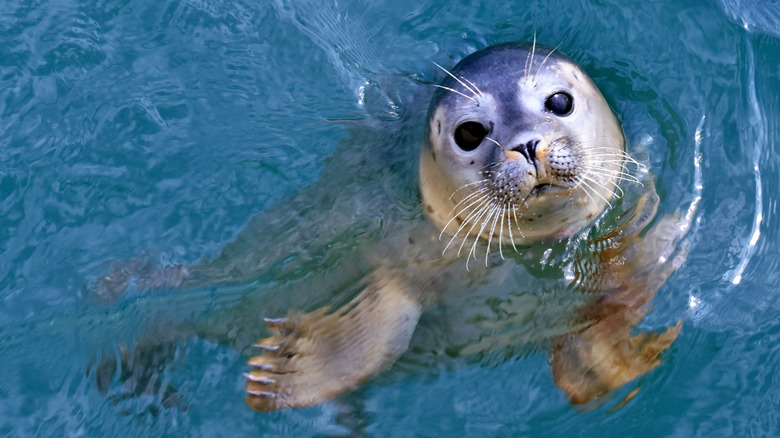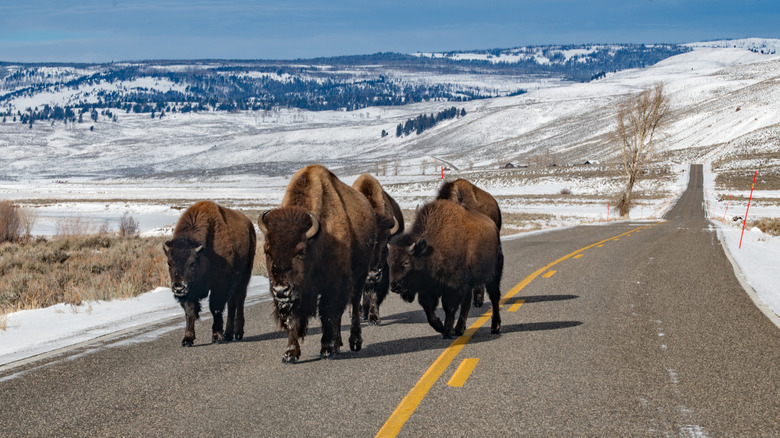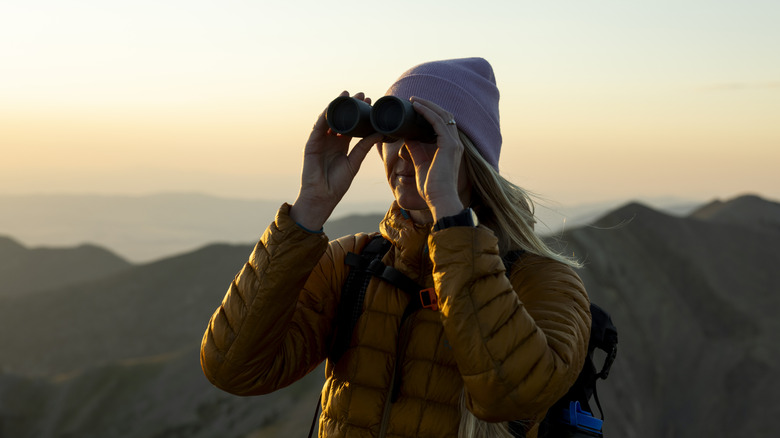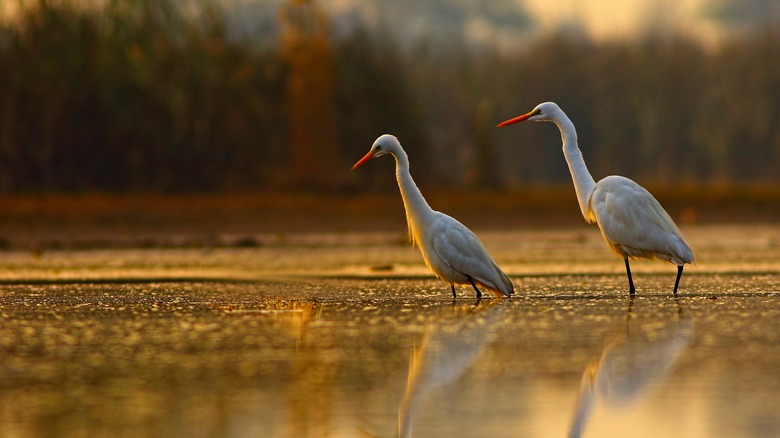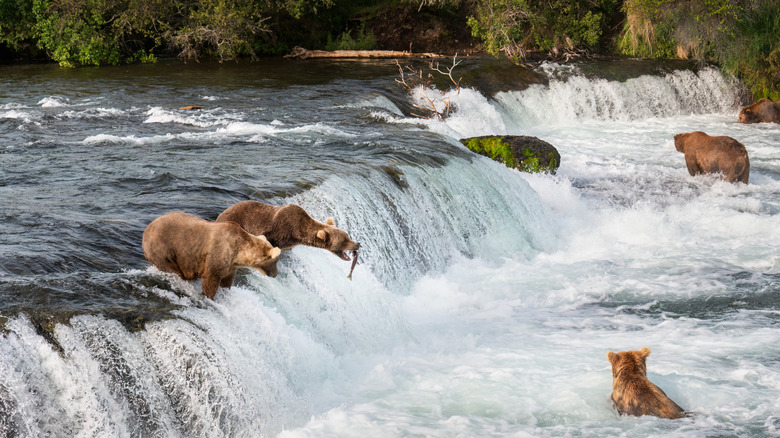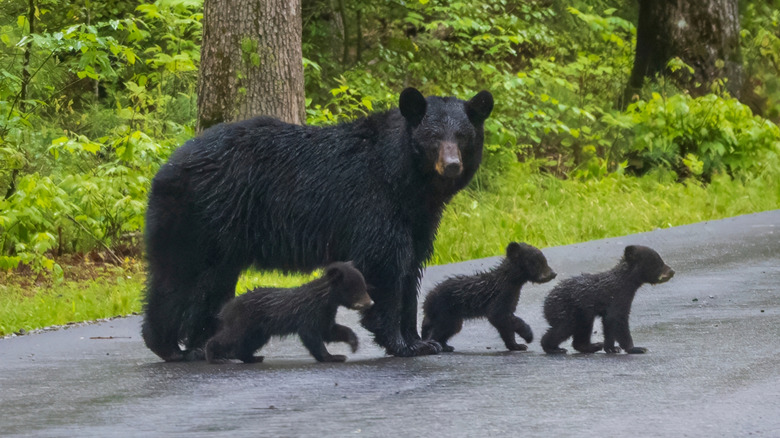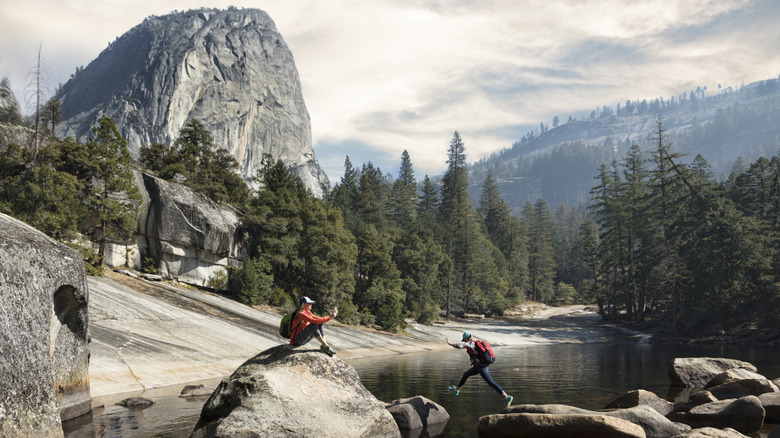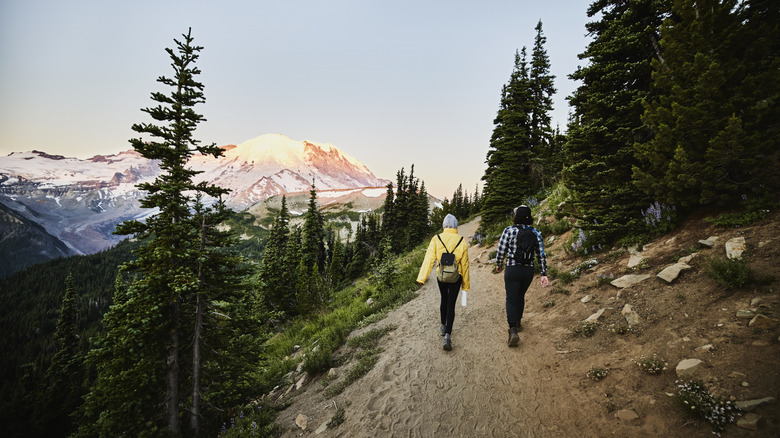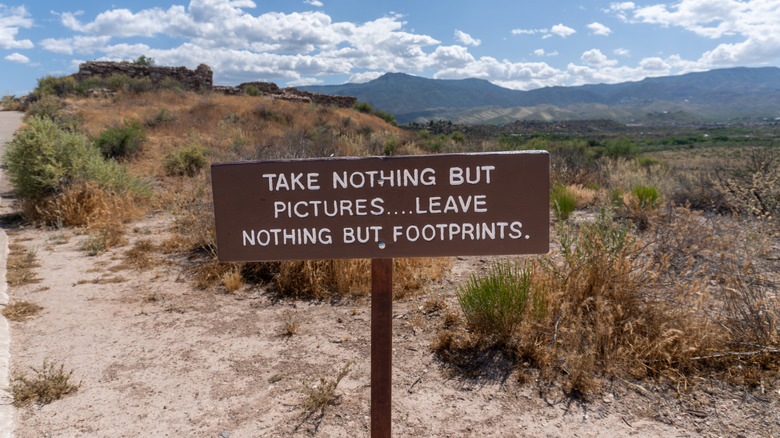Crucial Wildlife Tips Any Nature Enthusiast Needs To Know From National Park Services
The national park infrastructure found throughout the United States is one of immense beauty. Sixty-plus designated parks can be found scattered across the nation, and each one is home to an incomprehensible ecosystem of countless plants and animals that grow and thrive beyond the reach of human sprawl. The protected vistas across these parks encompass soaring mountain peaks, fertile valley floors, and numerous old-growth forests. These places fascinate visitors; some even host trees that have stood silently for centuries, many of which predate the formation of the United States.
A national park acts as a portal into another world, and there are some important things to keep in mind when entering one of America's protected wildernesses. As a visitor, it's your job to ensure you don't harm the landscape and wildlife that call it home. The National Park Service is a constant communicator of best practices in this regard and provides more than a few helpful tips to maintain a positive and enriching interaction with the land and its inhabitants. These are some of the most crucial to ensure a great day out in the park.
Don't disturb any animal you come into contact with
Maintaining a safe distance from any animal you might encounter while exploring a national park is perhaps the golden rule of good stewardship in these spectacular landscapes. The National Park Service strives to maintain critical balance in the ecosystems it's tasked with preserving, and this priority takes many forms. One way the park service accomplishes this goal is by mandating visitors not to engage with the animals they may come across. Approaching animals, making noises in an attempt to get their attention, or touching them if you are close enough can all lead to drastic outcomes. For one thing, you might spook the creature, which can result in unpredictable behavior. The wildlife can also inadvertently harm itself when it is startled.
In addition to the harm that may come to an animal, the unpredictability of their demeanor when placed in an unfamiliar situation like this can lead to significant injury to yourself. Large animals overpower humans by an order of magnitude that simply can't be discounted. Moose, cougars, bears, and even deer pack a significant punch that exponentially exceeds a human being's strength. In worst-case scenarios, bothering even a moderately sized animal can be a mistake that represents a person's last act on Earth.
Avoid feeding wild animals as well
In addition to touching, engaging with, or otherwise disturbing animals, it's also critically important that visitors to national parks do not feed the wildlife they may see while enjoying the landscape. Feeding animals seems like a harmless action. This activity is especially prevalent when hiking or sitting for lunch, and a squirrel or bird approaches you rather than the other way around. However, even small animals shouldn't be fed by humans.
Feeding the wildlife introduces a potentially disastrous ripple effect that can spur on significant and unexpected consequences farther along the food chain. When you feed animals, you're introducing something new into their diet. This can be damaging to their health, upsetting the delicate balance of the ecosystem in the process. Even if it doesn't create an immediate negative impact, feeding wildlife can quickly lead to dependency within a population.
Squirrels and other small animals that are frequently found around campsites and picnic areas quickly alter their hunting and food-gathering behavior once they discover that humans are willing to feed them on a regular basis. Shifting even one aspect of the ecosystem's balance in this regard can lead to detrimental effects elsewhere. There's no way to know how your interaction might impact the environment, so avoiding all forms of feeder behavior should always be a priority.
A seal may often appear to need help on the shoreline; it doesn't
Seals are a frequent sight in national parks with coastal landscapes. Harbor seals, for instance, are abundant in national parks along the West Coast. However, they're located everywhere in mid-to-high-latitude North America that borders the ocean. Because seals are such a common feature in aquatic national park scenes, visitors exploring these coastal climates might come across a seal behavior that appears troubling and dramatic.
Young seals are not strong swimmers, so their mothers typically leave them on the beach as they swim off to hunt for meals. Because of their youth — bringing relative physical weakness and a bit of general immaturity into the picture — juvenile seals often play around in the surf. This creates a distorted visual for onlookers, leading them to believe the seals are being thrashed by the tidal waves repeatedly. Onlookers may be horrified at this sight and think that the best thing they can do is run to the water and pull the seal out to safety.
The most important thing to keep in mind is that while they are born aquatic and destined to conquer water eventually, their adeptness will require time. Baby seals just behave this way and are not in any imminent danger of drowning or other harm, even though they may look to be struggling. Another reason why touching them is prohibited is because seals, for the most part, carry diseases that can be passed on to humans.
Always be patient when you see bison on the road
Bison are a staple in many national parks in the West. These gigantic and majestic creatures roam the plains and rugged elevations of this part of North America without much care. They also engage in migratory movements that frequently see them come into direct contact with humans visiting the parks. During the winter months, when the mountain passes and trails they frequent are covered in ice and snow, bison will instead navigate using the roadways that humans have erected throughout these wilderness regions. Roads tend to offer the easiest passageway for drivers and wildlife when the weather turns extreme, so interactions here are common during winter.
When you see a bison on the road, it might be tempting to drive up close or honk your horn to alert them to your presence. This action works well for people, and they'll typically leave the road and let you pass. However, bison aren't a part of the society we've created and would not understand that you want them to move. In fact, honking at bison on the road results in the opposite effect. Instead of moving out of your way, they will walk even slower. The best thing you can do when encountering these large animals on paved surfaces is to give them space and be patient.
Make sure you bring binoculars for a close-up view at a safe distance
The best way to view wildlife in a national park is from a safe distance that keeps all parties undisturbed. The most useful tool for this task is a pair of binoculars. Packing this device is just part of the process of gathering your gear for the day in a national park. Viewing wildlife through these lenses allows you to get a close-up view without bringing you into physical contact with them. It also allows the wildlife to go about their business peacefully and protects you from the danger that comes into the picture if you get too close. Dangerous predators like cougars, bears, and mountain lions bring in a major benefit through this method.
Binoculars also help you to preserve the natural habitat of other animals that don't pose direct safety risks. Birds, beavers, and even smaller animals like bees in a hive can all be seen in exacting detail with the help of your binoculars. If you get too close to any animal, it can introduce stress into the mix and cause them to act aggressively or drive them out of their habitat. Preserving the landscape for these animals is your duty as a visitor, and one of the best ways to achieve this is by viewing them from a distance.
You're too close to a bird if it reacts to your presence or actions
Birds can be restless creatures. Because they fly and travel quickly, they have the ability to leave your line of sight almost instantaneously. It's not enough to simply rely on your binoculars when viewing avian wildlife, as a result. However, one piece of advice can be applied to interactions with birds in the parks, particularly to snowy owls. If you are close enough for a bird to react to your presence or actions, you are too close to it.
The avian inhabitants of national park landscapes are often migratory by nature, acting as fleeting visitors rather than permanent dwellers. Some species travel thousands of miles on their migratory route to the park. When they arrive at their final destination, all of this traveling leads to a necessary rest period. Spooking a bird and making it rethink the safety of a particular perch it has chosen can be impactful in a way that doesn't affect many other animals. Being particularly mindful of the needs of birds in national parks is a great way to perform good stewardship of the area. Check out the local wildlife you'll likely see at Acadia National Park.
Be extra vigilant when it comes to bears in the spring
During the winter, after a rapid bulk up, bears hibernate in the colder months. They'll use up fat reserves and lose a significant amount of weight over this resting phase of their yearly behavioral cycle. As a result, when they exit the hibernation stage in the warmer spring months, they frequently become active hunters, looking to replenish the energy they've spent throughout the winter.
In the spring, bears are thin and agile, engaging in a much more active daily routine as they start to hunt and eat ahead of the summer and fall months, which ultimately see them bulk up once again. You'll spot bears on specific hikes in national parks, sometimes even while camping. This is far more likely to occur in the spring as they expand their activity load. Keeping this in mind if you plan to visit during this time of year is critically important. Encountering a bear when you least expect it can be a jarring experience. If you're unaware of this general cycle of activity, you might not know that bear encounters ramp up at this time of the year and be unprepared for the increased likelihood.
Stay calm and make yourself known if you encounter a bear
In addition to knowledge of seasonal bear activity, it's important to know what to do when you meet one. Seeing a bear in the woods can be a significant shock to even the most experienced hikers, but it doesn't have to be a tragic encounter. Calm demeanors win in these situations, allowing you to maintain careful control over the interaction. Bears don't typically want to involve themselves with humans. But they are a curious sort, and unexpected movements or giving in to the temptation to run away will almost certainly gain their attention and interest. If you run from a bear, expect it to chase you. They also engage in what is called a bluff charge, running directly at you and then veering off in one direction.
The best thing you can do if you see a bear is keep your distance. Remain facing the bear and begin speaking in its direction. Making noise to identify yourself will make the animal look at you if it hasn't already spotted you. However, backing away slowly and continuing to speak in its direction will more than likely yield the result you're looking for. Another thing to do if you encounter a bear is to take a moment and look out for bear cubs to ensure you aren't between a mother and her baby. Moving away from a cub as calmly and deliberately as possible while maintaining your composure is critical in removing yourself from the situation unharmed.
Visitors are responsible for their own safety and that of the animals they encounter
When exploring U.S. national parks, you need to remember that you are the more thoughtful and intelligent creature in any interaction with wildlife. Animals aren't devoid of thought, general understanding, and even sometimes complex thinking. However, as far as we know, they aren't capable of the significant levels of long-term strategy and planning that we exhibit as a species. This means that the onus of responsibility falls to us. Any situation that results in harm to yourself or an animal is likely one that could have been avoided by different choices on your part. Therefore, you are responsible for both your own safety and for the well-being of any animal you might come across while exploring a national park.
Keeping this responsibility in mind allows you to frame your visit positively. Remembering that visitors set the tone is important for all eager explorers. Maintaining the natural habitats that the wildlife in these areas rely upon and working to keep them safe and healthy by limiting interactions preserve the environment for everyone. Not only are you taking care of the wildlife that calls this place home, but you are also being a good steward for those who will visit after you.
Stay on designated trails and walkways
Adventurous travelers might be interested in seeking off-trail explorations during some of their visits to national parks. Plenty of park landscapes allow for this kind of wandering, although in some cases, you'll need a permit to go beyond the boundaries that define general access areas. However, this kind of advanced voyaging should only be undertaken by hikers and other individuals with plenty of experience in wilderness survival and backcountry movement. Even then, there's an additional responsibility that comes into the picture.
Do not veer off trails and walkways park rangers have marked. In parks that offer expansive freedom to move around and even pitch a tent, like Great Sand Dunes National Park (one of the best national parks for camping in the U.S.), this choice is far less impactful. However, many parks don't offer the same widespread freedoms. Moreover, boardwalks and other purpose-built trail facilities tend to meander their way through delicate ecosystems that can be detrimentally impacted if you hop the rail and start trudging around the forest or marshland on your own.
In addition to protecting the environment, staying on designated trails keeps you away from the home turf of potentially dangerous animals. The last thing you want to do is come across a sleeping mountain lion or a pack of wolves far away from assistance. Sticking to the marked trails keeps you safe in this way.
Leave no trace behind
The National Park Service's "leave no trace" policy is one that the organization takes seriously. This means taking anything you bring into the park back out of it when you leave. It also covers removing animals, items, and plant material from national parks. The best stewards of national park environments are those who come to see the ecosystem and leave without making any impact at all. Introducing new plant or animal life into a park can dramatically change the delicate balance of the environment, as can removing something.
Remembering that you are a transient visitor to a widespread and rich landscape that supports countless unseen lives dispersed throughout the wilderness helps put a sense of scale on things. We are all but mere passengers on what has been called "Spaceship Earth." Respecting the awesome natural forces at play in these spectacular environments is the duty of all humanity, so it falls to everyone who explores one of the country's national parks to show these landscapes the reverence they deserve. Take photographs, laugh, and enjoy life with the people you care about most in these magical snapshots of the Earth. However, remember to protect it at all costs.
